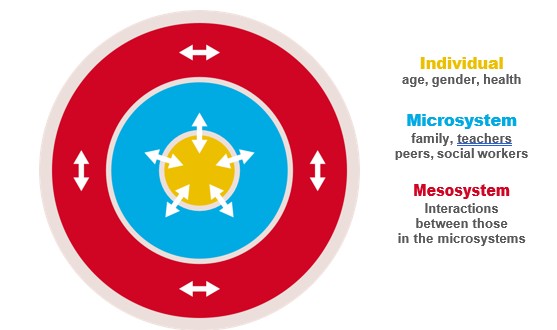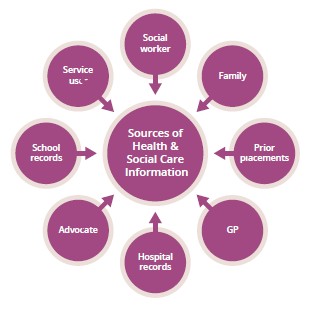Chapter 41 – Audrey Moore (D3SOP1)
Domain 3 Standard of Proficiency 1
Be able to gather all appropriate background information relevant to the service user’s health and social care needs.
|
KEY TERMS Identifying information required Safeguarding information Gathering information Alternative sources of information
|
Social care is … meeting a person where they are at, using skills, knowledge, experience and the relationship to assist them to create a life of their choosing. This proficiency allows the social care worker to find out where the service user is at. |
Identifying Background Information Required
Social care workers endeavour to engage with and ensure the best service is offered to service users. This cannot be achieved without all appropriate background information. Relevant appropriate background information refers to information needed to support and assist the service user. This can include personal information about a person’s family history and relationships, education and health assessments, prior placements and past interventions.
The background information required varies depending on the type of social care service on offer and on the individual’s health and social care needs at that point in time. For example, background information necessary to provide supports for a person living in full-time residential care can be much broader than the information required to provide supports for a person receiving support in a community day service. Each type of service is unique in the background information it requires.
Knowing where to start when gathering appropriate background information relevant to the service user’s health and social care needs can be a daunting task. Initially, background information can be gathered from the individual service user through interviewing or spending time with the person. For some, such as persons with disabilities or children, alternative sources of information may be required to gather the necessary information to provide the service. It might be helpful for the social care worker to use the ecological systems theory (Bronfenbrenner 1977) as a starting point (see Figure 1). Using the environmental systems within which an individual interacts to gather information, beginning with the individual, then moving to the microsystem (the groups and institutions that have most directly impacted on the individual’s development, such as family, school, community), a practitioner can identify many of the relevant sources of information for an individual. The mesosystem consists of interconnections between the microsystems, for example between the family and teachers or between the child’s peers and the family. By moving out through the layers of the ecological systems, further possible sources of information may be identified and further information may be gathered. See Box 2: Reflections on Practice for an example of this in practice.
Figure 1: Bronfenbrenner’s ecological systems

Effective communication is a vital skill for gathering the information needed. A practitioner needs to be able to convey clearly what they need and why they need it. Good written and oral communication is a necessary part of this skill, linking with relevant people, GPs, other medical professionals, social workers, family, and having some influence or compelling reason for the information to be given.
The more specific a request for information, the greater the chance of receiving it. For example, when searching for past daily records or behaviour incident reports, having a date or year is better than requesting ‘all’ or ‘any’ of these records. Information sources such as social work departments or residential services may not have the resources to trawl through files to find vague information requests. A specific request with a compelling rationale will garner more co-operation. As seen in the reflections on practice, the social care worker needs to consider the quality of the information gathered and be able to distinguish between fact-based information and opinion-based information.
Factual and Opinion-based Information
Factual Information
Information that can be verified or supported by documentation. Examples include date of birth; dates of attendance at school or work; qualifications; dates of hospital admissions; medical records; psychological or psychiatric assessments or diagnoses.
Opinion-based Information
Subjective information that may be the result of a person’s perspective, understanding, particular feelings, beliefs and desires. Two different people may have different opinions based on the same facts. Examples include memories of family, friends, teachers, colleagues, etc.; eyewitness accounts of an event or events; professional opinions in case notes or assessments.
Reflections on Practice
During my time working in an admissions assessment unit and residential care in the community, service users were sometimes admitted with limited background information and limited ability to convey the information required to help them. This limited knowledge of the service user’s background information was at times compounded by challenging behaviour and difficulty settling in by the new admission. Trust was often a significant issue and had to be built up between the staff members and the person and their family.
As part of my role as social care worker, I used tools to assess the needs of the service user, such as an admissions form, needs assessment or comprehensive behaviour supports assessment (see Chapters 2-5 in Domain 3 for further information on assessments). This often required the gathering of information from many areas of a person’s life: medical history, family history, education, employment history, social history. Informal interviews with service users coupled with a person’s file notes would garner much information. Oftentimes, the service user proved very helpful in indicating their needs and wishes. However, where the service user was a child or had an intellectual disability, the informal interviews were not as effective because they were often unable to remember or provide details from their past. Alternative sources of background information were required to gather all relevant information.
Family members are the natural next step as a source of information; however, depending on the circumstances of admission, family members were often not accessible or not open to sharing information, or, in many cases, not reliable with details they shared. Where families were available and open to sharing, great care was required when asking about sensitive topics in order to preserve the developing relationship between social care worker/key worker and family. Diplomacy and good judgement were key skills needed for these interactions. Identifying key persons in the family who could provide reliable information proved effective on several occasions. Using Bronfenbrenner’s ecological systems theory, other individuals could be identified in the person’s microsystem as good sources of information, such as teachers, GP and social workers. At times, oral accounts of events conflicted with each other and with prior documentation. A clear distinction had to be made between factual information and opinion-based information when documenting information (see Box 1).
Support plans and programmes were developed and implemented despite some gaps in information. Some gaps in information were filled as the relationship and trust grew between social care worker and family or quite by accident during conversation with a family member or other professional. For example, relevant yet unknown past medical history was revealed by a parent while chatting with a social care worker, despite the parent having been asked for medical history information when the service user was admitted. While it is not always necessary to gather significant amounts of information about a person’s health and social care needs, large gaps in information can hinder the support provided to a service user and therefore action may be needed. The process has helped me to learn how to gather information in a tactful and non-threatening manner with individuals, professionals and families and realise that different approaches may be needed depending on the person being approached.
Safeguarding Service Users’ Information
In the course of their work, social care workers are privy to a lot of personal and sensitive information about service users and their families. Practitioners must understand and respect the confidentiality of the information they have been given as well as the limits of confidentiality in the context of their role in a social care setting. (See Chapters 4, 10-12 and 14, Domain 1: Professional Autonomy and Accountability for further information on confidentiality).
Practitioners must be aware of and practice within the legal boundaries of data protection legislation[1] by protecting the personal data of service users. See Box 3 for an explanation of some relevant terms related to data protection legislation. Data protection principles ensure that personal information is processed in a lawful, fair and transparent manner, only for the purpose specified to the individual when collected, is accurate and kept up to date, is only stored for as long as necessary for the specified purpose and is done in a way that ensures security, integrity and confidentiality. In order to collect personal data from or about a service user, consent must be freely given, specific, informed and unambiguous. Documentary evidence of consent must be maintained and the individual has the right to withdraw consent at their will. Children under 13 years of age can only give consent with permission from their parent. See dataprotection.ie for further information.
General Data Protection Regulation Terms Explained
Personal Data
Any information relating to a person, identifiable directly or indirectly by name, ID number, or other identifiable factors related to that person.
Processing Personal Data
Any action performed on or with a person’s personal information whether manually or by automated means including collecting, recording, organising, storage, consultation, use, disclosure or destruction.
TASK 1
Think about your own personal information. Do you know what organisations or companies have access to your personal data? How is it processed? What consent have you given?
Gathering Information from the Individual – Interviewing
Personal interviewing is helpful for gathering appropriate background information relevant to a service user’s health and social care needs and is employed by social care workers in many different settings (Allen & Langford 2008). Interviewing can help a practitioner, through active listening, gain an understanding of the other person and their lived experience. Good practice for personal interviewing ensures effective information gathering and the practitioner can glean much more than through the spoken word. How a person presents in terms of their appearance, demeanour, speech, pitch, tone, facial expressions and body language can add complexity and depth to the information gathered. For example, if a person is saying one thing but their tone of voice and body language indicate the opposite, a skilled social care worker may identify and address this.
|
GOOD PRACTICE TIPS FOR INTERVIEWING
|
|
Ensure the area allows adequate privacy for the conversation, with limited distractions. |
|
Sit at the individual’s level and make eye contact if it is culturally appropriate for them. |
|
Sit in a relaxed position and use open body language during the interaction. |
|
Speak to the individual’s level of understanding; avoid jargon and organisation-specific abbreviations. |
|
Listen attentively and stay centred on the conversation – use active listening skills. |
|
Open questions are useful when exploring. For example, ‘Tell me about your experience at school.’ |
|
Closed questions are useful when seeking specific answers or clarifying. For example. ‘What year did you complete your education?’ |
|
Document responses as you go, by taking brief notes. Write up the appropriate details of the interview as soon as possible afterwards. Writing brief notes will assist recall later, while writing too much when interviewing may impede the flow of information. |
Special considerations need to be made when gathering information from or interviewing children as their safety and wellbeing is of primary concern. Child protection guidelines must be followed in all interactions with children. Some information-gathering tools in use for children in social care include the Three Houses method and life story work. The Three Houses method is a useful tool which brings the voices of children and families forward when gathering information for the planning of interventions and services (Weld 2008). See domain 3.2 for a further explanation of The Three Houses. Life story work may also be helpful in some situations to assist children to make sense of their past. Care must be taken when gathering information from children, particularly where they have been victims of criminal activity or abuse. Great knowledge and skills are required for formal interviews with children due to the risk of harming or re-traumatising a child who has suffered (Wilson & Powell 2001) and should only be carried out by persons trained to do so.
Alternative Sources of Background Information
There will be times when gathering information from an individual service user is difficult. This might include working with a service user who has not been part of services before and cannot provide reliable information, or where the service user is a child. In these cases, a social care worker may need to source information from third parties such as family, other social or health care professionals or other services. See Box 4 for alternative sources of health and social care information.
Oftentimes, due to a range of factors, information is difficult to get access to or is simply unavailable. These factors could include a family’s distrust of services, a language barrier or where a service user originated from another country. See Box 2 for an example of how the developing relationships with service users’ family members were utilised to identify people who could provide reliable information. A social care worker sometimes needs to get creative to access information and use resources and skills at hand to piece together information. A social care worker can use oral accounts as well as documentation to build a picture of a service user’s background information. Box 5 outlines the advantages and disadvantages of these sources of information. Triangulation can be used as a method to validate the information collected. This involves comparing information gathered through interviews, documentation and observation. Despite being time-consuming and requiring greater planning and organisation, triangulation allows practitioners to confirm and verify information gathered from various sources.
Sources of background information

|
Advantages and Disadvantages of Oral and Documented Sources of Information
|
||
|
|
Advantages
|
Disadvantages |
|
Oral accounts Formal or informal interviews with an individual, their family, previous support staff, teachers and others. |
|
|
|
Documentation Social work records, daily records, school reports, case histories, personal planning information, psychological assessments, social work reports, incident/accident reports. |
|
|
![]() Tips for Practice Educators
Tips for Practice Educators
This proficiency will require students to have an understanding of how information is gathered in relation to service users’ health and social care needs. Organisations or services may use specific methods or tools to gather information relevant to the service user’s health and social care needs, such as interviewing techniques or forms. Forms may include specific documents or templates in either hard copy or electronic. It would be helpful to discuss the methods or tools employed by the service with the student, allowing them to explore examples from the placement and familiarise themselves with methods or tools in use in the organisation for this purpose.
Introduce the student to the information systems in use in the organisation for individuals’ personal information. This may include information storage systems (computer files, hard copy files, filing cabinets), security, disposal and archiving. Share any relevant policies and procedures with the student on information gathering, storage, disposal and archiving.
Giving a student the opportunity while on placement to examine the personal plans of service users with their consent could create an opportunity for the student to learn about the categories of information gathered on individuals. Although not suitable in all settings, a service user might show the contents of their personal file to a student, sharing their past life experiences, family history and significant life events.
Should the opportunity arise, a student may benefit from shadowing a staff member who is in the process of gathering relevant background information.
How does the service manage information for service users transitioning to or from other services? Discuss this with the student, including the legal implications of processing personal data.
The student can be encouraged to reflect on the following:
- The purpose of gathering information relating to a person’s needs
- The different types of health and social care information that may be gathered
- The methods used to source and gather relevant information
- Boundaries in relation to what information is relevant and what is not
- The significance of confidentiality in relation to a person’s personal information
- Legislation in relation to collecting, storing and using personal information.
References
Allen, G. and Langford, D. (2008) Effective Interviewing in Social Work and Social Care: A Practical Guide. London: Palgrave Macmillan.
Bronfenbrenner, U. (1977) ‘Toward an experimental ecology of human development’, American Psychologist 32(7): 513.
Weld, N. (2008) ‘The Three Houses Tool: Building Safety and Positive Change’ in M. Calder (ed.), Contemporary Risk Assessment in Safeguarding Children. Lyme Regis: Russell House.
Wilson, C. and Powell, M. (2001) A Guide to Interviewing Children: Essential Skills for Counsellors, Police, Lawyers and Social Workers. New York: Routledge.
- General Data Protection Regulation (GDPR), Data Protection Act 2018, the ‘Law Enforcement Directive’ (Directive (EU) 2016/680), which has been transposed into Irish law by way of the Data Protection Act 2018, the Data Protection Acts 1988 and 2003, the 2011 ‘ePrivacy Regulations’ (S.I. No. 336 of 2011 – the European Communities (Electronic Communications Networks and Services) (Privacy And Electronic Communications) Regulations 2011). ↵

